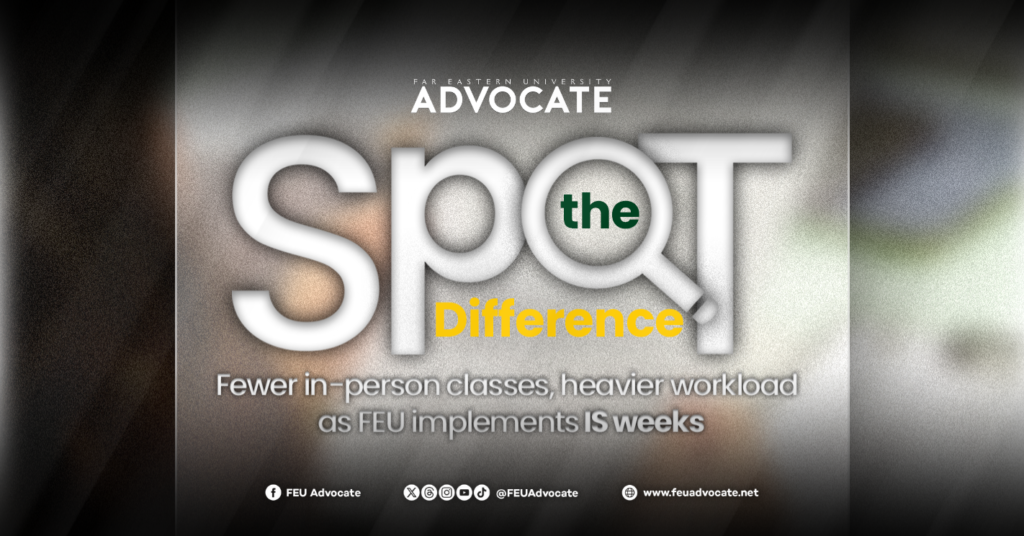
Darapan on first Season 86 goal: 'Job’s not done'
- March 14, 2024 14:29
FEU Advocate
June 12, 2025 19:44

by Cassandra Luis J. De Leon and Kasharelle Javier
Far Eastern University (FEU) introduced independent study (IS) weeks for the second semester of S.Y 2024–2025, aiming to create expanded learning spaces and work-life balance to make learning more flexible. However, numerous students have expressed that lack of onsite classes may lead to academic compromises.
For the second semester, the Institute of Arts and Sciences (IAS) and the Institute of Education (IE) integrated the IS modality.
General Education (GED) subjects also followed the same modality, while the Life and Works of Rizal subject transitioned to fully online.

1. Onsite Classes
The University follows a policy that specifies the required number of weeks per unit, but due to the new modality, five weeks were deducted from in-person meetings, compared to the previous semester’s 19 weeks.
The IS weeks were held last January 27 to February 1, February 24 to March 1, March 6 to March 12, and April 14 to 16, which fell on Holy Week, and May 7 to 13.
Furthermore, IS weeks may be adjusted or cancelled by the University in case of class suspensions, subject to the discretion of the GED Department in consultation with faculty members, students, as well as the approval of the Academic Executive Council.
During this semester, there were two high heat index-related suspensions, and one partial day suspension due to One Concierto Piyu.
Meanwhile, face-to-face classes were shifted to independent study on three other days. In total, there were six days of class disruptions beside the five-week IS periods.

2. Allowed Absences
Given that only 20 percent of absences are allowed based on the guidelines of the Commission on Higher Education, adjustments of allowable absences were necessary for this semester with IS weeks.
Students enrolled in a 54-hour subject consisting of 15 hours of IS and 39 hours of onsite classes are only allowed to be absent for a maximum of five sessions.
Meanwhile, blended learning courses with a total of 27 hours of face-to-face meetings allowed only two absences.
In comparison to previous semesters, six absences are allowed for classes with twice-a-week meetings, while courses with one class per week permitted three absences.

3. Number of Assessments
Based on students’ sentiments, lack of onsite classes prompted compromise in assessments, heightening weight and adding pressure in managing the academic workloads.
In an interview with FEU Advocate, second-year Communication student Myzqah Siriban shared his struggles in keeping up with academic requirements since the implementation of IS weeks.
“Personally, nahihirapan ako matuto ‘pag mayroong IS. Sometimes, ‘di ako maka-keep up at ‘di ako makagawa ng activities gawa nga ng nahihirapan akong matuto during IS… Mahirap na makahabol sa academic calendar lalo na ‘pag mga lab courses tulad ng Video Editing,” he expressed.
IAS students, especially those in Bachelor of Science programs like Biology, Psychology, Chemistry, Applied Mathematics, and Physics, are required to conduct laboratory activities onsite, making the implementation of IS a challenge for courses that demand hands-on learning.
Meanwhile, specialized IE courses, such as in Science and Mathematics majors as well as those which require physical health facilities, also have laboratory classes
Second-year Communication student Gerald Dinaya shared the same sentiments regarding the workloads which, according to him, increased compared to before.
“Dati, kahit papaano naki-keep track ko pa ‘yung mga deadlines ko. Ngayon kasi parang isang bagsakan lahat and minsan magkakadikit pa ‘yung deadline ng mga gawain sa iba’t ibang subject. So, for me, mas nakaka-burnout siya agad, and at the same time, mas nakaka-pressure,” Dinaya stressed.
For a third-year Communication student who chose to remain anonymous, the assessments under the implemented policy have their pros and cons.
“IS has affected me in many ways… One thing na natutuhan ko while having an IS week is to organize 'yung mga bagay na need ko gawin… Hindi pa rin perfect 'yung pag-manage ko ng time, pero somehow nakaka-help siya to improve it little by little,” they discussed.
However, the interviewee admitted that they faced difficulties in learning due to the number of subjects they were enrolled in this semester.
“Mahirap siya since I have nine subjects sa semester na ito. So 'yung learning perception ko is somehow napupunta sa ‘basta maipasa’ na lang,” the student added.
Meanwhile, second-year International Studies student Andrea Christine Espinosa echoed the same sentiment of experiencing heavier workloads.
“The implementation of the IS Week was a bit premature and still on a ‘trial’ stage… Although I do acknowledge and understand the aim of the modality, which is to lessen the workloads and stress of students, that did not happen because of how they implemented it… Having an independent study week did not lessen our workloads but rather added to it,” the student said.

4. Professors’ supervision and learning environment
Meanwhile, Espinosa also emphasized how the shift to independent study made learning more challenging due to lesser guidance from professors.
“It also takes more time for us to self-study as well, compared to when we are able to learn our lessons during in-person classes, with our professors helping us understand,” Espinosa explained.
She also added that dormitories are not conducive for learning given that there are more distractions.
Second-year Psychology student Edelweiss Quennie Duay echoed her concern that IS weeks have added more stress, as they often had to complete activities without prior discussions.
"With IS week, mas dumagdag lang ‘yung stress for us students since some of the activities we do, wala pang prior discussions from the professors and parang nagpapasa na lang kami ng FAs for the grades but wala kami natututuhan sa activities,” she stressed.

5. Transportation and Dorming Allowance of Students
The implementation of IS has received mixed reactions from student commuters and dormers, reflecting the varying ways it has impacted their daily routines and financial responsibilities.
As a commuter, Siriban shared that his transportation expenses have decreased due to IS as they no longer need to commute everyday to campus.
Meanwhile, Dinaya mentioned that staying in his dormitory is impractical despite having fewer class days as it increased his food and essentials expenses. Hence, he would choose to go home instead during IS weeks.
“As a dormer dito sa España [Boulevard] nahihirapan talaga ako ma-sustain ‘yung mga essentials ko dito tulad ng ulam at bigas. Kung bibili naman ako ng ulam sa labas mabilis mauubos allowance ko nun,” he stated.
Additionally, Dinaya mentioned that he prefers going home to Pateros during IS weeks as he can eat healthier meals and save money compared to staying in his dorm where he resorts to affordable meals like siomai rice and sometimes eats once a day.
For Espinosa, IS days also affect the total cost of their utility bills.
“I think that it’s impractical for us to stay in our dormitories because our expenses would also increase. We may be less burdened by transportation expenses, but we also consume more electricity, water, etc. when we stay in our dorms especially if we have no classes,” she said.
Moreover, Duay underscored that her expenses are not proportional to her time in school as she often travels back to Manila just to attend a day or two of onsite classes, doubling her travel costs instead of saving money by staying in the province.
“Mas napapamahal pa gastos namin since imbis na we can go home for a week and makatipid, bumabalik pa kami ulit sa Manila just for one or two school days and nadodoble lang gastos namin sa pamasahe,” she stated.
An advisory from the Academic Affairs Office (AAO) containing a survey regarding the students’ thoughts on this modality was posted last April 22, regarding the implementation of blended learning across all institutes.
Several town hall meetings and ongoing consultations have also been held with student-leaders and the AAO.
Despite conducting consultations, students’ woes reveal that the implementation of IS weeks did not anticipate all the struggles that they would face. While its intention is to provide flexibility, the challenges faced by students suggest that their involvement in the decision-making process is essential to implement student-centered policies.









